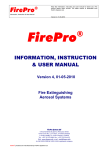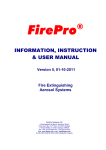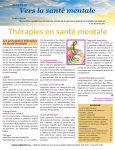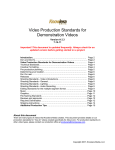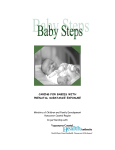Download OPENING UP A USER'S GUIDE - Parents for Children's Mental Health
Transcript
Authors: Kathy Short, Ph.D., C.Psych., Director, School Mental Health ASSIST OPENINGUP AUSER’SGUIDE Michelle Bates, MSW, RSW, Mental Health Lead, Hamilton Wentworth District School Board It is important to review the User’s Guide prior to presentation of the Opening Up Video. The video is designed to reach both hearts and minds, and it is important to the integrity of the message of the video as well as the context to present the video utilizing the parameters of this User’s Guide. The User’s Guide provides outlines for a variety of audiences as well as presentation styles. Sarah Cannon, Executive Director Parents for Children’s Mental Health Table of Contents Purpose of Guide .......................................................................................................................................... 2 Introducing Video...................................................................................................................................... 2 Talking Points……………………………………………………………………………………………………………………………………….3 Facilitated Questions.................................................................................................................................... 4 For All Audiences....................................................................................................................................... 4 For Senior Administrators…………………………………………………………………………………………………………………….4 For School Mental Health Professionals……………………..………………………………………………………………………..5 For Community Mental Health Professionals……………………………………………………………………………………….5 For Principals……………………………………………………………………………………………………………………………………….6 For Teachers………………………………………………………………………………………………………………………………………..7 For Parents/Youth……………………………………………………………………………………………………………………………….8 For School Board Trustees…………………………………………………………………………………………………………………..8 In a Workshop Setting……………………………………………………………………………………………………………………….9 Acknowledgements and Contact………………………………………………………………………………………………………16 Page 1 of 16 Purpose of the Guide: Opening Up is a video that provides us a window into the journey of families struggling and coping with the unique challenges of raising children and youth with mental health disorders and mental illness. Designed for those in education, Opening Up shares with us the family perspective. A true partnership, this video was collaboratively produced by Parents for Children’s Mental Health Ontario, Hamilton-Wentworth District School Board, and the School-based Mental Health and Substance Abuse Consortium, and was funded through the Mental Health Commission of Canada and the Student Support Leadership Initiative Hamilton. We believe that the Opening Up video and guide can be a useful tool to complement mental health literacy efforts within school districts. The Opening UP video and guide can be used to help develop and/or enhance awareness, or they can be used as part of a professional learning/professional development opportunity with various audiences. This User Guide contains some suggestions for how the video might be used to stimulate dialogue with various audience groupings within your district. The notes are only suggestions for your consideration. Purpose of the video: Opening Up creates opportunities for dialogue, partnership and understanding to improve outcomes for children and youth. It is suitable for a wide variety of audiences, and can be used to: develop/enhance awareness stimulate discussion create environments that welcome conversation about mental health and mental illness be part of a professional learning/professional development opportunity Introducing the video: Opening Up is designed to reach both hearts and minds. We think it is best offered in the context of shared conversation. For many staff members, mental health will be a personal topic affecting loved ones or themselves, with some audience members being parents of children with mental health disorders or mental illness. It is important to acknowledge this reality when sharing the video, and to anticipate that viewing this may be an emotional experience for some. For this reason, it is recommended that the video be presented sensitively, with opportunity for personal and collective reflection, as appropriate for your setting and audience. Page 2 of 16 The following are some talking points that might be helpful to you when introducing the video: The 10 minute video you are about to see was developed by families, educators and community partners to provide a window into the journey of families struggling and coping with the unique challenges of raising children and youth with mental health disorders and mental illness. Designed for those in education, Opening Up shares with us the family perspective. In the development process, parent groups and teachers were consulted. Families commented frequently on how deeply the video resonated with them. As educators we know and see our students every day in our classrooms and schools. We believe that families are essential as team members. What we might not see, nor understand fully are the struggles that families experience, and the ways in which we can be part of a circle of care. Parents are students’ first teachers. Today, this video is an opportunity for parents to teach us. Families share their experiences, yet, the specific diagnoses of their children are not identified. This was done so we could get to know their children, not their labels. Each family’s journey is unique, yet many of the families in this video had similar experiences and reactions. Opening up wasn’t easy for all of the parents in the video, yet, they did so with the belief that by sharing their journey they could contribute to deeper understanding and opportunities for dialogue and partnership between educators and families. We gratefully acknowledge the families who gave their time, shared deeply personal experiences and took some risks participating in this unscripted video. Their commitment to their children is inspiring. It comes naturally to us to consider things from our educator lens. We invite you to watch this video and consider – ‘what if this was my child?’ Page 3 of 16 Facilitated Questions For All Audiences – For reflection (individually and/or in groups) about the experience of families, and how schools can help support them Guiding Questions: Which stories and messages from the video resonated most with you? What is something new you learned, or was reinforced for you, from this video? How would you describe the assumptions about families’ experiences that exist within your setting? Which of these assumptions might need to be challenged in your setting? Think about a time when you needed something for your child or a loved one. What did that feel like to need something from a helping professional? What happened that was helpful? For Senior Administrators – To invite dialogue about our understanding of families’ journeys, and the ways that we can help them Guiding Questions: In what ways do our actions, language and practices support families on their journey? What policies, procedures and practices do we have in place that support families on their journey? In what ways could we do better? How do we ensure that we understand children beyond their label? Page 4 of 16 For School Mental Health Professionals – To reinforce staff advocacy and skill in understanding families’ journeys Guiding Questions: Which stories and messages from the video resonated most with you? What is something new you learned, or was reinforced for you, from this video? How would you describe the assumptions about families’ experiences that exist within your setting? Which of these assumptions might need to be challenged in your setting? Share a time when you challenged an assumption (yours or someone else’s) about a family’s journey. What made this experience successful? Share a time when you helped staff to see a child beyond their label. In what ways have you helped to be a part of an ‘opening up’ conversation? What are the essential ingredients of working together – parents and school staff? For Community Mental Health Professionals – To provide insight into how schools are working toward a deeper understanding of their role in supporting families Guiding Questions: Which stories and messages from the video resonated most with you? Share a time when you challenged an assumption (yours or someone else’s) about a family’s journey. What made this experience successful? Share a time when you helped school staff to see the child beyond their label. Page 5 of 16 For Principals – To build awareness about the experience of families, and the role that educators can play in providing support for families and their children Guiding Questions: Which stories and messages from the video resonated most with you? What learning is new or was reinforced for you, from this video? How would you describe the assumptions about families’ experiences that exist within your setting? Which of these assumptions might need to be challenged in your setting? Share a time when you challenged an assumption (yours or someone else’s) about a family’s journey. What made this experience successful? Share a time when you helped school staff to see a child beyond their label. What feedback have you received from families? In what ways have you helped to be a part of an ‘opening up’ conversation? In this video what did school staff do that made a difference for these families? What are the essential ingredients of working together – parents and school staff? In this video, parents have shared that they are often called to meetings at a time when they feel de-skilled. What do you do to help parents feel skilled? In your school, do staff know: • • • • The warning signs and symptoms of when a child may be experiencing a mental health problem or a mental illness, including warning signs of suicide? The difference between behaviors versus symptoms? What to do if a child expresses suicidal ideation or exhibits warning signs of suicide? Who they can turn to for help for a child within your school? Page 6 of 16 For Teachers – To build awareness about the importance of understanding the family perspective, and the role that educators can play in providing support. Guiding Questions: What have parents experienced? In this video what did school staff do that made a difference for these families? What are the essential ingredients of working together – parents and school staff? How do I communicate to families that I understand their journey? In what ways do I support families during their journey? What feedback have I received from families? How do I ensure that I am seeing the child, and not just their label? In what ways do my actions, language and practices encourage families to open up? Share a time when you were part of an ‘opening up’ conversation. What made this situation successful? Think about a time when you needed something for your child or a loved one. What did that feel like to need something from a helping professional? What happened that was helpful? Do you need more information regarding: • • • • The warning signs and symptoms of when a child may be experiencing a mental health problem or a mental illness, including warning signs of suicide? The difference between behaviors versus symptoms? What to do if a child expresses suicidal ideation or exhibits warning signs of suicide? Who you can turn to for help for a child within your school? Page 7 of 16 For Parents and Youth – To demonstrate the activities the school district is engaged in to enhance educator mental health literacy and reduce stigma. Guiding Questions: Are these the right messages to convey to educators about a family’s perspective? Is there anything else you would want to tell them? Is there anything in particular that an educator can do or say to help when families are going through this experience? In this video what did school staff do that made a difference for these families? What are the essential ingredients of working together – parents and school staff? For School Board Trustees - To bring awareness regarding a parent perspective, and the ways that the education system can support students and their families Guiding Questions: What have parents experienced? In this video what did school staff do that made a difference for these families? What are the essential ingredients of working together – parents and school staff? How do I communicate to families that I understand their journey? In what ways do I support families during their journey? In your role, what are the ways that you can help build system capacity (understanding and skill) to provide support to families? Page 8 of 16 Inaworkshopsetting The Opening Up video can be used to introduce a mental health professional development session, or it can be used as the focus of the workshop. The following are some suggestions and activities that can be utilized during a workshop that includes Opening Up. Opening Up introduces us to four families, all with different situations, family settings, backgrounds, and experiences, yet many with the same theme about struggles and emotions. Families share with us their experiences and their emotions. The following is intended to act as suggestions for workshops where Opening Up can be utilized, it is not intended or designed to act as a complete workshop guide. It is the intention to act as a jumping off point for workshops that intend to address mental health disorder, mental illnesses and their impacts, and strategies and tools for within the education setting. The guiding questions found at the front of this guidebook can help guide activities, or be used to be build additional or more focused activities around the questions. What do you consider the definition of family? Considerations while developing a standard definition of family: In a report prepared by the Community Research, Planning and Evaluation Team at CAMH (2004) family is defined as “an inclusive way to include kin and significant others, that is family can be anyone a client views as important because of a strong enduring connection with that person”. While this definition seems to be inclusive, it should also be noted that most definitions of family do not include the foster family (Horwitz et al., 2010). However, foster families or guardians can be a very important part of planning for recovery and this definition also does not include those people who provide significant unpaid care and support to a person with mental health issues and who may or may not be considered by the client as family (Lakeman, 2008). Parents for Children’s Mental Health, and SynergyResearch, define family as “ A circle of care and support offering enduring commitment to care for one another related either biologically, emotionally, or legally and takes into account those who the “client” identified as significant to his/her well-being “ (Cannon, Dostaler – Family Engagement Training Curriculum) Page 9 of 16 ACTIVITY: Have participants (either in groups, or individually) write on cue cards one word that is integral in the definition of family. The facilitator should gather the cards and post . With the participants, group in themes or similar words. It is not important for this exercise to create a “definition”, but rather identify and recognize the fact that there are many components of family, and not all are “traditional”. Discuss how participants’ settings are inclusive when considering the family of students. How did families feel? How might this impact engagement with them? It is important to keep in mind the emotional impact and the emotional journey of families who are struggling with raising children and youth with mental illness, as well as the emotional impact on the child/youth. Families in Opening Up shared some of the emotions and reactions they have experienced in their journey. As educators it is understood that engagement and partnership with families is important to the success of our students. How does the emotional impact of the family journey impact on school relationships and trust? ACTIVITY: Have participants (either in groups, or individually) list some of the common emotions heard throughout the video. Think of circumstances where as an educator you have been involved in a situation where those emotions (negative or positive) have been a factor. Ask participants – What do you feel the most common emotion, or expression was throughout the stories of all the families? Page 10 of 16 ACTIVITY: (option 2) Ask participants to think back to a time when they were in a situation where the outcomes were dependant on someone else. ie: crossing the border; applying for a mortgage; applying for a job, or a job interview Discuss the impact and the process they went through to deal with the emotions, and keeping the end objective in mind. Discuss how these situations could be compared to a family’s journey raising a child and youth with mental illness, specifically within situations within the education sector. Impacts on the whole family Opening Up shows us that there are many layers to the impacts of raising children and youth with mental illness, and that it can be easily forgotten when we focus solely on the outcomes for that child or youth the impacts it may be having on others. Most specifically, the child’s siblings. Oftentimes children and youth with mental illness have siblings, and it is important for us to remember that they too are impacted by the challenges as well as perhaps the impressions or thoughts of others. Considerations/Guiding Questions: How would you describe the assumptions about siblings that exist within your setting? Which of these assumptions might need to be challenged in your setting? Can you identify situations where siblings have been called on to assist in a situation involving their siblings’ mental health challenges? What impacts might this participation have had on the sibling? Does your setting have policies and procedures in place for addressing when and if appropriate to involve siblings? Are there opportunities to open up conversation with the sibling within your setting about the impact to them specifically? Does your setting have a list of resources or known available programs for siblings that may be struggling due to the impact of the family’s challenges? Has there been education provided on ways to identify and intervene on sibling specific challenges? Page 11 of 16 Behaviours versus Symptoms One of the clear messages in Opening Up was a suggestion to change the historical view of “behaviours” and recognize them as “symptoms of an illness”. It is difficult to change a universal view that has been embedded in so many for so long. Begin these conversations by thinking about paradigm shifts. Invite participants to think of a paradigm shift as a change from one way of thinking to another. It is a revolution, a transformation, a sort of metamorphosis. It does not just happen, but rather it is driven by agents of change. The World English Dictionary defines paradigm shift as….a radical change in underlying beliefs or theory What is an agent of change? An excerpt from Dennis Stevenson’s What is a Change Agent Dictionary definitions are ok, I suppose. But in this case, I think it misses the essence of what it means to be a change agent. I think there is more to it than just understanding or repeating a definition. Change agent is as much about identity and character as it is any definitions. I offer the following explanations for how it feels to be a change agent. * A change agent lives in the future, not the present. Regardless of what is going on today, a change agent has a vision of what could or should be and uses that as the governing sense of action. To a certain extent, a change agent is dissatisfied with what they see around them, in favor of a much better vision of the future. Without this future drive, the change agent can lose their way. * A change agent is fueled by passion, and inspires passion in others, Change is hard work. It takes a lot of energy. Don't underestimate this. I like to think about the amount of energy it takes to boil water. From 212 degree water to 212 degree steam takes a lot more energy than heating water from 211 degrees to 212 degrees. In my experience, without passion, it is very difficult indeed to muster up enough energy to assault the fortress of status quo that seems to otherwise carry the day. * A change agent has a strong ability to self-motivate. There will be many days where everyone around does not understand and will not offer props. The change agent needs to find it within themselves to get up every day and come to work and risk being misunderstood and misappreciated, knowing that the real validation may be far in the future and may be claimed by someone else. * A change agent must understand people. at the end of the day, change is about people. If you change everything but the people, I doubt you'll be effective as a change agent. Change will really "stick" when people embrace it. Therefore, change is part sales, part counseling and part encouragement. It's all about people. Page 12 of 16 ACTIVITY: Ask participants to think about the definition and comment on how it feels to be an agent of change and reflect and comment on how it is similar to that of being a teacher or educator. Ask participants to think about a time or situation where they were an “agent of change”. How did that feel? How was that accomplished? ACTIVITY: How Can I Be an Agent of Change? Ask participants to think about the idea of behaviours versus symptoms. Invite them to consider their role as an agent of change on how they might be able to influence this paradigm shift. List situations where a “behaviour” is an obvious reaction to an environmental or emotional trigger. Are these situations considered “behaviours” or “symptoms”? What are the positive impacts that can be realized by a paradigm shift in thinking in these situations? Compare the difference in how a situation would be treated if the situation was viewed as “behaviour” and then what would need to be different to view it as a “symptom”? Listen, Care, Understand, Be There Opening Up sends this message – Listen, Care, Understand, Be There - as central throughout the video Invite the participants to celebrate a time when they were able to embody and to Listen, Care, Understand, Be there . Ask participants who are willing to share to tell their story, to describe the Page 13 of 16 situation and how they were able to Listen, Care, Understand, Be There , and what that looked like, and what the impact was on the family, themselves, and the situation. The following chart, developed by families lists Do’s and Don’ts related to how we can Listen, Care, Understand, Be There. D O ’ S AND D ON ’ TS FOR FROM THE VOICE OF FAMILIES Do Have understanding and compassion. We need you to understand the stress that we may be dealing with, or the uncertainty that we are faced with. Recognize that we as families are “experts” in our child’s care. No one knows our children as well as we do. Ask families how things are going at home, or how things have been going over the past few weeks. We may be able to share some important additional context that is important to our child’s care that they might not otherwise share. Act as an advocate for us. Often, we don’t know where to turn, or even what services are available. We need your help to navigate the system, and to find the proper supports for our child. Have and promote hope for our child. Recognize that you as a service provider and we, as a family, may have very different ideas culturally about mental health, and treatment. We need to work together to find options that fit with the worldview of our family. Follow through on what you say you are going to do. We depend on you keeping your appointments, making those phone calls, or following through on those next steps. Be patient. Look at our work together as an equal partnership. Listen to our needs, goals, and desires, and work to achieve them together. Recognize the uniqueness of each child, and each family. Treat our children and families with dignity and respect, and use language that respects us as individuals. Use language that we can understand. Think about how you would feel if it were someone talking to you or your child. Celebrate successes with us. Don’t Blame our child’s difficulties on our lack of parenting skills or make assumptions about home situations based on stigma, or prejudice. Assume that because you have education and training in mental health that you know best for our child. Shut us out of the process. Sometimes we need to be able to add information to what our child is telling you. Tell us that “our organization doesn’t offer that” and turn us away, or stop looking for solutions. Dwell on the worst case scenario, or make it seem unlikely that our child will be unable to contribute to their community. Offer culturally incompatible opportunities or treatment and wonder why we aren’t engaged. Change appointments, don’t call us when you say you are going to, or don’t call other agencies/professionals when those were part of our next steps. We are quickly turned off when we feel neglected or ignored. Push to meet a preconceived timeline of therapy. Make decisions without us, or assume you know what’s best. Don’t discount our experiences and the benefits they can offer. Assume that we need the same things as other families. We may have different beliefs, family circumstances, or challenges. Use language that hurts, is not clear, or doesn’t include my strengths, beliefs, and experiences. For example, refer to us by name, not just “Taylor’s mom”. Use acronyms or technical language that can be confusing to us. Treat me in ways you would not like to be treated or have your own child treated. Base successes on societal norms instead of allowing Page 14 of 16 Do Acknowledge efforts of the present. Include strategies to strengthen the whole child/family. Listen, hear, and understand. Be prepared to use more than one situation to form opinions. Remain calm and anchored. Don’t children their own success based on their own capacity Base decisions, judgments, and opinions solely on “behaviours”. Be stuck in only utilizing clinical therapy and what outcomes are suggested through academic evidence. Assume you have heard it all before. Base judgments on one setting/appointment. Allow emotion to anger you. Taken from the work done by Parents for Children’s Mental Health and SynergyRec “Developing a Family Engagement Strategy”. ACTIVITY: Using a family scenario (or a couple of different scenarios from examples of what educators may face in their individual settings), ask participants to look at the scenario and the chart and identify if the methods employed in their current setting would fall under the Do or Don’t category, or a combination of both. Ask participants to give specific examples where possible. Now ask participants to think about what methods or actions the scenario would require to have all the pieces fall under the Do category. Invite participants to share their findings and what their scenario would involve to ensure all pieces were what families consider Listen, Care, Understand, Be There. Invite the group to spend some time discussing challenges and barriers to implementing this, and what the facilitators of those barriers may be. Page 15 of 16 Do you have questions, or suggestions for improving this User Guide? Please contact us with your ideas! [email protected] We gratefully acknowledge those who appeared in the video : Families: Pam Freeman, Wendy Summer Hayes, Cindy Currie, Sid Stacey, Sarah Cannon, Parents for Children’s Mental Health Senator Michael Kirby, Partners for Mental Health For project development and financial contributions we thank : Hamilton-Wentworth District School Board Mental Health Commission of Canada School-Based Mental Health and Substance Abuse Consortium Student Support Leadership Initiative, Hamilton For Video Production we thank: Patrick Hanson, Corporate Communications, Hamilton-Wentworth District School Board For Music we thank: Karen Taylor-Good www.karentaylorgood.com “The Life That Has Chosen Me” Page 16 of 16

















